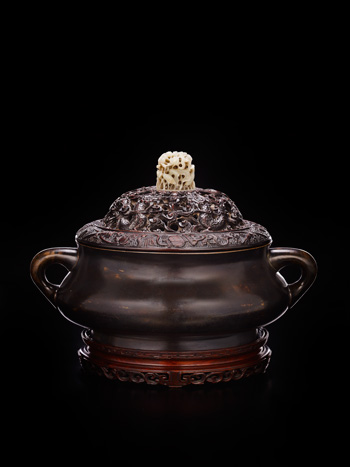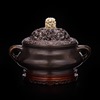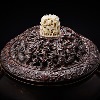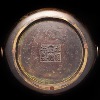The present lot of a charming censer exhibits qualities of the elegant form and exquisite casting techniques on the bulbous censer found in the Xuande yiqi tupu. The inspiration behind the circular foot, bowl shaped container and looped handles resembles the physical attributes of a bronze gui vessels, which in antiquity were used for offerings of boiled grain. The cover embellished with a combination of the meticulous depiction of four writhing dragons under the intricately worked finial of egrets and blossoms testify to the superb craftsmanship of the present lot. While the cover serves an aesthetic function, it also serves to prevent dust from getting inside the interior, which might taint the fragrance of the incense. The bronze censer of the Xuande reign had been highly sought after by connoisseurs and collectors traditionally for its impeccable quality, as the Xuande emperor had been known to commission the production of various bronze vessels for Imperial altars, offices and halls of the palace after receiving fourteen and five-eighths tons of copper as tribute. Compare with a censer of similar form with a reticulated bronze cover toppled with a jade finial but composed of jade on the body, illustrated in The complete collection of treasures of the palace museum, Jadeware II, Hong Kong, pl.182, p.230. See also another censer of similar form, illustrated in China’s Renaissance in Bronze. The Robert H.Clague Collection of Later Chinese Bronzes, Phoenix Art Museum, 1993, pl.35, p.170-171. Compare with a small censer with a domed-shaped cover similarly surmounted by a delicate jade finial, sold at Sotheby’s Hong Kong, 8 October 2010, lot 2714.
|
8046
A BRONZE DRAGON CENSER
MING DYLASTY |
|
Of compressed bulbous form resting on a flattened circular base, flanked by loop handles on the waisted neck rising to a gently flared rim extending to the patinated interior, the plain body extends to a patinated interior, the reticulated cover decorated with four five-clawed writhing scaly dragon in full flight amidst dense swirling clouds rendered in openwork, encircled with a band of the eight emblems against a ground of keyfrets on the outer rim, surmounted by a jade finial exquisitely worked to the scene of egrets perch next to an blossoming lotus with its head gently lifted up in a graceful posture, the base with the six character reign mark within a slightly sunken square cartouche. |
|
Estimate
2,500,000 - 4,000,000 9,766,000 - 15,625,000 322,200 - 515,500
|
|
Sold Price 2,640,000
10,232,558
340,645
|
|
|
The present lot of a charming censer exhibits qualities of the elegant form and exquisite casting techniques on the bulbous censer found in the Xuande yiqi tupu. The inspiration behind the circular foot, bowl shaped container and looped handles resembles the physical attributes of a bronze gui vessels, which in antiquity were used for offerings of boiled grain. The cover embellished with a combination of the meticulous depiction of four writhing dragons under the intricately worked finial of egrets and blossoms testify to the superb craftsmanship of the present lot. While the cover serves an aesthetic function, it also serves to prevent dust from getting inside the interior, which might taint the fragrance of the incense. The bronze censer of the Xuande reign had been highly sought after by connoisseurs and collectors traditionally for its impeccable quality, as the Xuande emperor had been known to commission the production of various bronze vessels for Imperial altars, offices and halls of the palace after receiving fourteen and five-eighths tons of copper as tribute. Compare with a censer of similar form with a reticulated bronze cover toppled with a jade finial but composed of jade on the body, illustrated in The complete collection of treasures of the palace museum, Jadeware II, Hong Kong, pl.182, p.230. See also another censer of similar form, illustrated in China’s Renaissance in Bronze. The Robert H.Clague Collection of Later Chinese Bronzes, Phoenix Art Museum, 1993, pl.35, p.170-171. Compare with a small censer with a domed-shaped cover similarly surmounted by a delicate jade finial, sold at Sotheby’s Hong Kong, 8 October 2010, lot 2714.



